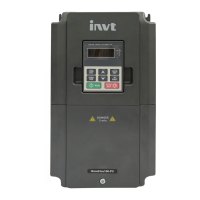Do you have a question about the INVT GD100-018G-4-PV and is the answer not in the manual?
Provides essential safety guidelines for VFD operation, wiring, and component handling.
Outlines safety precautions for VFD delivery and installation to prevent hazards.
Details safety measures required during VFD commissioning and operation.
Specifies safety procedures for VFD maintenance and component replacement.
Covers the requirements for the physical installation of the VFD.
Details the environmental conditions required for optimal VFD performance.
Explains the standard procedures and best practices for VFD wiring.
Details the functions and connections for the VFD's main circuit terminals.
Lists and describes the functions of the VFD's control circuit terminals.
Introduces the VFD keypad, its buttons, and basic functions.
Explains the different display states and parameters shown on the VFD keypad.
Guides users on how to operate the VFD using the control panel keypad.
Details special functions and configurations for PV inverter operation.
Provides an overview of VFD fault diagnosis and troubleshooting procedures.
Covers OUt1, OUt2, OUt3 faults related to inverter unit phase protection.
Details OV1, OV2, OV3 (overvoltage) and OC1, OC2, OC3 (overcurrent) faults.
Covers UV (undervoltage), OL1, OL2 (overload), SPI, SPO (phase loss) faults.
Details OH1, OH2 (overheat), EF (external), CE (communication), ItE, EEP faults.
Covers PV faults (PINV, PVOC, PVOV, PVLV) and system faults (dEu, STo, LL).
Explains A-LL (underload), A-tF (full-water), and A-tL (empty-water) alarms.
| Model | GD100-018G-4-PV |
|---|---|
| Type | Solar Inverter |
| Rated Power | 18.5 kW |
| Efficiency | 98% |
| Protection Level | IP20 |
| Cooling Method | Forced Air Cooling |
| Operating Temperature | -10°C to +50°C |
| Storage Temperature | -20°C to +60°C |
| Output Voltage | 3-phase, 380V |
| PV Input Voltage | 600V (Max 800V) |
| Frequency Range | 50/60Hz |
| Humidity | 5% to 95% (non-condensing) |
| Altitude | ≤ 2000m |











